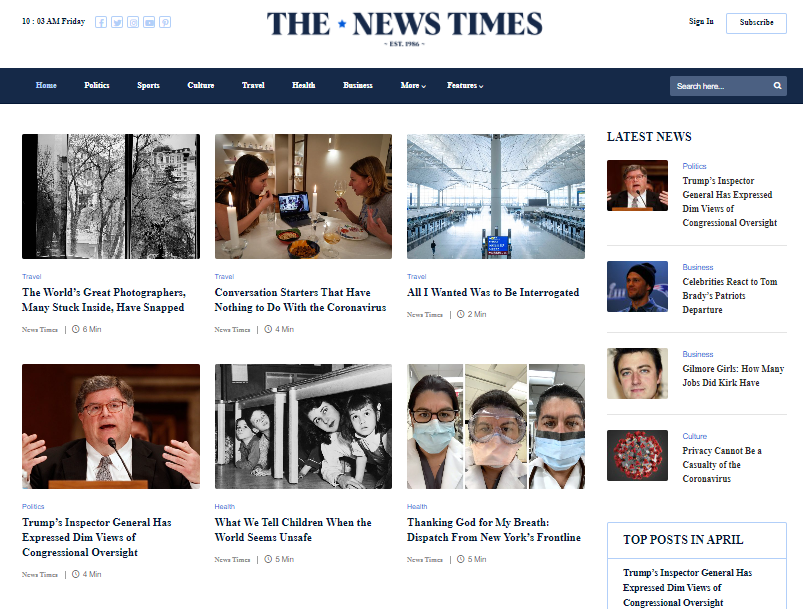Everything You Need to Know About stnews.live and How It Works
Discovering the Future of Journalism: What's Next for News Online?
The future of journalism is developing swiftly in the digital landscape. Standard techniques are being challenged by new technologies and changing audience habits. Social media, expert system, and interactive narration are improving how details is shared and taken in. As newsrooms adapt, they encounter crucial questions regarding count on and principles. What approaches will arise to guarantee integrity amidst these changes? The solutions can redefine journalism as we recognize it.
The Impact of Social Network on News Intake
As social media systems continue to develop, they have fundamentally changed news usage patterns. Typically, audiences relied on newspapers and tv for info; nonetheless, the increase of platforms like Twitter, Facebook, and Instagram has actually shifted this dynamic - stnews.live. News is currently accessible in real-time, with individuals getting updates straight with their feeds. This immediacy enables quick circulation of details yet typically at the cost of detailed fact-checking
Additionally, formulas curate content based on customer preferences, causing the sensation of echo chambers, where individuals are subjected mainly to perspectives that straighten with their very own. This can hinder vital interaction with varied perspectives. Furthermore, the interactivity of social networks makes it possible for individuals to take part in conversations and share material, even more influencing public discourse. The role of typical journalism is evolving, requiring adaptation to maintain integrity and relevance in an increasingly electronic landscape.
The Duty of Artificial Knowledge in Journalism
While the combination of synthetic knowledge (AI) right into journalism provides interesting chances, it likewise increases substantial questions about the future of news manufacturing and intake (stnews.live). AI technologies can streamline operations by automating regular jobs such as information analysis, fact-checking, and even content generation. This can enhance efficiency and permit journalists to concentrate on more complex storytelling aspects. Problems about accuracy and bias occur as formulas might unintentionally bolster misinformation or mirror the prejudices of their designers.
Furthermore, making use of AI in personalizing news feeds can result in resemble chambers, where visitors are only exposed to perspectives that reinforce their present beliefs - stnews.live. Honest factors to consider are vital, especially concerning transparency in AI-generated web content and the responsibility of wire service in utilizing these devices. As AI proceeds to develop, its duty in journalism will demand ongoing dialogue regarding the effects for credibility, liability, and the general trustworthiness of news

Technologies in Narration and Multimedia Reporting
The landscape of journalism is being transformed by technologies in narration and multimedia reporting. Interactive narration techniques engage target markets in brand-new methods, allowing them to get involved in stories, while virtual reality journalism involves audiences in experiences that typical styles can not reproduce. These developments not only boost target market interaction however likewise redefine exactly how news is presented and taken in.
Interactive Narration Strategies
Ingenious interactive narration methods are transforming the landscape of journalism, involving target markets in means traditional stories can not. These techniques integrate multimedia components such as videos, infographics, and interactive maps, permitting readers to check out tales dynamically. By encouraging target markets to browse and individualize their experience, reporters create deeper links with their content. Interactive quizzes and surveys even more boost involvement, motivating participation and feedback. In addition, social media sites assimilation makes it possible for real-time conversations, promoting a community around the tale. Significantly, these techniques not just attract interest yet likewise promote understanding of complicated problems, making journalism more easily accessible. As wire service welcome these advancements, the possibility for immersive storytelling remains to expand, forming the future of exactly how info is offered and eaten.
Virtual Fact Journalism
As wire service progressively take on digital truth (VIRTUAL REALITY) technology, journalism is going into a new era of immersive storytelling that astounds audiences like never ever in the past. Virtual reality journalism allows viewers to tip into the narrative, experiencing events from a first-person point of view. This cutting-edge method boosts emotional interaction, as individuals can basically navigate crisis zones, witness historic moments, or check out complex social issues. By incorporating conventional coverage with 360-degree video and interactive elements, virtual reality journalism advertises much deeper understanding and compassion. Obstacles remain, consisting of access, manufacturing costs, and the requirement for honest standards. As the modern technology progresses, it guarantees to improve how news is consumed, pushing the limits of narrative and redefining the relationship in between journalists and their target markets.
The Transforming Landscape of Newsrooms
While traditional newsrooms when functioned as the foundation of journalism, they now deal with considerable change because of technological innovations and changing audience choices. The rise of digital media has caused the decrease of print journalism, prompting wire service to adjust their structures and operations. Lots of have moved to hybrid designs, incorporating online systems with typical reporting approaches to get to wider audiences.
This shift has actually also influenced staffing, as newsrooms increasingly hire information analysts, social media sites strategists, and multimedia journalists to diversify web content and enhance engagement. Furthermore, the focus on speed and material production has actually resulted in the application of innovative innovations, such as man-made intelligence, to simplify operations.
Consequently, the landscape of newsrooms now shows a more collective atmosphere, urging cross-functional groups to work together in providing timely and relevant news stories. This evolution indicates an important period for journalism as it looks for to browse the complexities of a digital-first globe.
Audience Engagement and the New Characteristics of Depend On
Audience involvement has ended up being essential in establishing count on within the developing landscape of journalism. By utilizing interactive narration strategies and executing openness and liability measures, news companies can cultivate an extra trusted connection with their target market. These techniques are necessary for adapting to the new characteristics of trust that specify modern media usage.
Building Rely On Journalism
Count on in journalism has actually ended up being progressively breakable in a period dominated by misinformation and fast technical advancements. why not try here As audiences run into a frustrating quantity of info, critical reputable sources has actually come to be an obstacle. Reporters and news companies are currently urged to prioritize transparency and dependability to regain target market confidence. This consists of giving clear sourcing, fact-checking procedures, and honestly addressing mistakes. Involving target markets straight through social media and neighborhood discussion forums promotes a sense of involvement and accountability. Additionally, media proficiency initiatives are vital, gearing up the public with tools to critically assess news content. Eventually, restoring trust calls for a cumulative initiative from reporters, companies, and audiences alike, ensuring that top quality journalism dominates amidst the noise of digital media.
Interactive Narration Methods
The developing landscape of journalism needs ingenious methods to engage audiences and reinforce depend on. Interactive narration methods have actually become a powerful device for news organizations, permitting them to present details in vibrant and immersive methods. By including multimedia components such as video clips, infographics, and interactive maps, reporters can develop engaging stories that motivate active engagement from viewers. This interaction cultivates a deeper connection to the material, improving the overall user experience. In addition, interactive narration can promote customized content delivery, providing to diverse target market interests and preferences. As journalists welcome these strategies, they not only mesmerize target markets however likewise add to a more enlightened public, eventually reinforcing the count on between news organizations and their readers in an increasingly digital age.
Openness and Accountability Actions

The Future of Ethical Journalism in the Digital Age
Integrity stays a foundation of journalism, especially as the electronic age changes the landscape of info circulation. In this advancing setting, moral journalism deals with unprecedented obstacles and possibilities. The proliferation of misinformation and the fast spread of unproven news demand a renewed dedication to precision, justness, and openness. Journalists need to navigate the complexities of social media systems, where the line between coverage and point of view usually blurs.

The increase of fabricated knowledge in content production increases moral inquiries pertaining to authorship and accountability. As audiences increasingly require credibility, media organizations are tasked with reinforcing their moral criteria to keep public count on. Collaborative efforts amongst reporters, innovation companies, and regulative bodies will certainly be crucial in crafting standards that prioritize ethical techniques. Ultimately, the future of ethical journalism depends upon a cumulative feedback to these challenges, making certain that stability stays at the forefront of news reporting in the electronic age.
Often Asked Concerns
How Do News Organizations Monetize Online Journalism Efficiently?
News companies efficiently monetize online journalism through varied approaches, consisting of membership versions, targeted marketing, sponsored content, and published here collaborations. These approaches allow them to create revenue while keeping journalistic integrity and engaging their target market effectively.
What Skills Are Important for Future Journalists in the Digital Age?
Future journalists should grow digital proficiency, multimedia storytelling, information analysis, and social networks efficiency. Flexibility and vital reasoning are crucial, allowing them to navigate progressing modern technologies and audience preferences in an increasingly complicated media landscape.
Exactly How Will Journalism Adapt to Altering Audience Demographics?
Journalism will adapt to changing audience demographics by accepting varied content formats, leveraging data analytics for targeted narration, and cultivating community engagement via interactive platforms. These approaches intend to enhance significance and access for advancing audiences.
What Duty Do Person Reporters Play in the Future of News?
Person reporters are increasingly essential fit news narratives, offering diverse viewpoints and prompt coverage. Their payments challenge traditional media, fostering a more comprehensive information landscape, while likewise increasing worries about precision and liability in coverage.

How Can Small News Outlets Compete With Larger Media Companies Online?
Small news electrical outlets can compete with larger media companies on-line by concentrating on specific niche markets, developing strong community links, leveraging social media sites for involvement, and delivering distinct, local content that resonates with their target market's specific rate of interests.